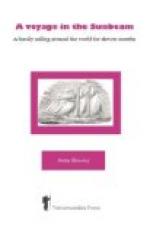[Illustration: Japanese Boats.]
CHAPTER XIX.
YOKOHAMA.
Heavily plunged the breaking wave, And foam flew up the lea, Morning and evening the drifted snow Fell into the dark grey sea.
Tuesday, January 30th.—When we awoke from our slumbers this morning, it was very cold and dark, and we heard noises of a strange kind. On going on deck to ascertain the cause of this state of things, we discovered that the sky-lights and portholes were all covered and blocked up with snow, and that the water froze as it came out of the hose, forming a sheet of ice on the deck. Masses of snow and ice were falling from the rigging, and everything betokened that our welcome to Japan would not be a warm one.
[Illustration: Fujiyama, Japan]
After breakfast we had many visitors, and received letters from Sir Harry and Lady Parkes, inviting us to go up to Yeddo to-morrow for a long day, to settle our future plans.
Having landed, we went with the Consul to the native town, to see the curio shops, which are a speciality of the place. The inhabitants are wonderfully clever at making all sorts of curiosities, and the manufactories of so-called ‘antique bronzes’ and ‘old china’ are two of the most wonderful sights in Yokohama. The way in which they scrape, crack, chip, mend, and colour the various articles, cover them with dust, partially clean them, and imitate the marks and signatures of celebrated makers, is more creditable to their ingenuity than to their honesty. Still, there are a good many genuine old relics from the temples, and from the large houses of the reduced Daimios, to be picked up, if you go the right way to work, though the supply is limited. Dealers are plentiful, and travellers, especially from America, are increasing in numbers. When we first made acquaintance with the shops we thought they seemed full of beautiful things, but even one day’s shopping, in the company of experienced people, has educated our taste and taught us a great deal; though we have still much to learn. There are very respectable-looking lacquer cabinets ranging in price from 5_s_. to 20_l_. But they are only made for the foreign market. No such things exist in a Japanese home. A really good bit of old lacquer (the best is generally made into the form of a small box, a portable medicine-chest, or a chow-chow box) is worth from 20_l_. to 200_l_. We saw one box, about three inches square, which was valued at 45_l_.; and a collection of really good lacquer would be costly and difficult to procure even here. The best specimens I have ever seen are at Lady Alcock’s; but they are all either royal or princely presents, not to be bought with money. The tests of good lacquer are its exquisite finish, its satiny, oily feel, and the impossibility of making any impression on it with your thumb-nail. It is practically




